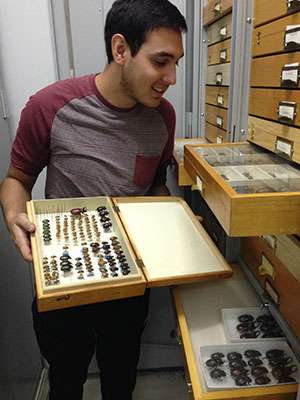Undergraduate discovers new firefly species

The Entomology Research Museum at the University of California, Riverside today announced the discovery of a new species of firefly from Southern California, collected by an undergraduate student as part of his semester's insect collection.
Doug Yanega, senior museum scientist, said the student, Joshua Oliva, obtained one specimen of the new species while collecting near Topanga, Calif.
"He wasn't 100 percent certain it was a firefly, and brought it to me for confirmation," Yanega said. "I know the local fauna well enough that within minutes I was able to tell him he had found something entirely new to science. I don't think I've seen a happier student in my life."
Yanega explained that, contrary to popular misconception, there are a few fireflies—actually nocturnal beetles that feed on snails—that live in Southern California. They tend to occur in very small and highly localized populations near springs and seeps, where they are infrequently encountered.
"One reason we are bringing this discovery to the public's attention is that it seems likely that this beetle may be highly restricted in distribution, and the habitat where it occurs may require consideration for some level of protection, at least until we can learn more about it," Yanega said.
The discovery of new insect species is more common than people might assume.
"It's important to keep this in perspective," Yanega said. "Researchers at UC Riverside discover a few dozen new insect species every year, from all around the world, including new local species. While it's unusual for an undergraduate student to find a new species, this has happened before, and shows nicely how a little careful effort can pay off in a big way."
This particular case, Yanega said, is also unusual in that it is rare for someone to be in a position to recognize a specimen as belonging to a new species so soon after it is first collected.
"It's pretty typical for specimens of new insect species to sit in a collection for a decade or more before an expert comes along who has enough familiarity with that particular type of insect to be able to recognize that it's something new, but I was able to tell this one was interesting right away, and compared it to reference material in our museum," he said. "This is why it is essential for scientists to collect and keep insect specimens."
UCR's collection contains nearly 4 million specimens collected over more than 100 years, with new species being found among them on a regular basis. Photos of the new firefly specimen were sent to the University of Florida's Marc Branham and Joe Cicero, world authorities on fireflies, who confirmed Yanega's initial conclusion.
The new species has not yet been formally named. Yanega pointed out that the naming process could take several years.
"The act of formally describing a new species is like gathering evidence for a court case, and might require the examination of specimens from many different collections in order to build a list of all of the features that make this species different from related known species, or even involve DNA sequencing," he said. "It's uncertain how long it might take to do it properly."
Asked if the new species might be named after the student who collected it, Yanega said the choice of a name is up to the scientist who writes the description.
"But it's not unusual for new species' names to honor the person who first collected them," he added.
Oliva, 24, who graduated earlier this month, found the new firefly species in mid-May 2015. He has been fascinated by insects since he was a little boy. He grew up in Guatemala and came to the United States when he was 9 years old. He attended high school in Northridge, Calif., and joined UCR in 2009. He now plans to apply to UCR for graduate studies in entomology.
"My discovery shows me that the field of entomology has a lot of opportunities for hardworking students," he said.
The firefly Oliva found is about half a centimeter long and black in color with an orange halo-like pattern on the shield covering its head (the pronotum), and a small luminescent organ at the tip of the tail.
"I've heard back from the experts in Florida," Yanega said. "They both saw the photos, and agree this is something new, and they want to describe it. The process may involve describing additional species in the same genus, so they can't say how long it might be before a name is formally decided upon and published."
Provided by University of California - Riverside





















